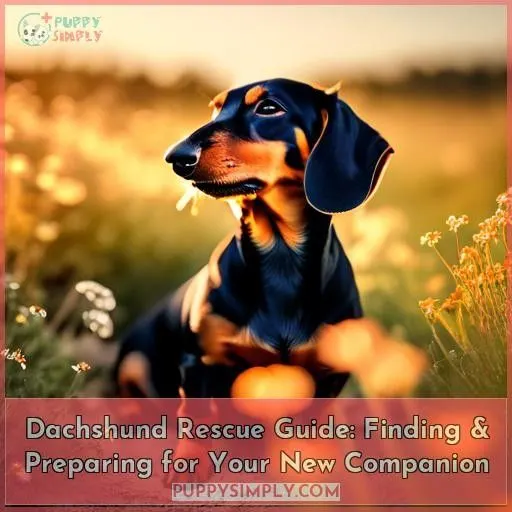This site is supported by our readers. We may earn a commission, at no cost to you, if you purchase through links.

Adopting a dachshund rescue can be an incredibly rewarding experience, but it’s crucial to comprehend their distinctive requirements and challenges. These devoted pups are prone to spinal issues, cutaneous sensitivities, and other health concerns that require preventative care.
You’ll also need to understand how to address their emotional attachments, possessiveness, and compulsive behaviors. Initiate by dachshund-proofing your home, implementing crate training, and supplying enrichment toys.
Training and socialization are vital to mitigating any hostility or separation distress. If you’re prepared to embrace the joy and responsibility of a devoted dachshund companion, continue reading to unravel the secrets of fostering an unbreakable bond with your new furry friend.
Table Of Contents
Key Takeaways
- Research Dachshund rescues: Utilize resources like Dachshund Rescue Organizations and Petfinder to find local Dachshund rescue organizations.
- Understand their needs: Dachshunds have unique requirements, including spinal issues, skin allergies, and emotional attachments to toys.
- Prepare your home: Dachshund-proof your home, implement crate training, and provide enrichment toys to ensure a safe and comfortable environment.
- Training and socialization: Training and socialization are crucial for mitigating aggression, separation anxiety, and other behavioral issues.
What to Expect When Adopting a Dachshund
When adopting a dachshund, you can expect a loyal, loving companion with unique behaviors. Your new furry friend may develop emotional attachment to toys, showing maternal instincts or carrying them around like babies.
Dog jealousy can manifest when other dogs receive more attention or access to toys, leading to aggression or excessive barking. Obsessive behavior around toys may include pacing, whining, or hoarding. Toy destruction can be an outlet for pent-up energy or frustration.
To support your new companion, consider using iGive to donate regularly and shop at 2,000+ stores. As you bond with your rescue dachshund, remember to address any behavioral issues and provide a safe, comfortable environment for your new family member.
Preparing Your Home for a New Dachshund
Preparing your home for a new dachshund puppy involves a few key steps. Start by proofing your home, ensuring all hazardous items are out of reach. Crate training will provide a safe space for your pup.
Selecting appropriate toys, food bowls, and pet insurance are essential for their comfort and well-being. Be aware of dog jealousy and obsession, which can manifest as resource guarding or destruction. Understanding dog psychology can help you manage these behaviors.
A well-prepared home is the foundation for a happy, healthy, and well-adjusted dachshund.
Understanding Dachshund Health Concerns
As a first-time dachshund owner, it’s essential to be aware of the health concerns that accompany the breed. Dachshunds are prone to various health issues, including intervertebral disc disease (IVDD), cherry eye, patellar luxation, dental disease, and skin allergies. Here are three key points to assist you in managing these health concerns:
- Intervertebral Disc Disease (IVDD): Dachshunds have a higher likelihood of developing IVDD, which can result in back pain, weakness, and even paralysis. This condition is more prevalent in older dogs and can be treated with medical intervention or surgery.
- Cherry Eye: This refers to the protrusion of the tear gland of the third eyelid, causing discomfort and irritation. Prompt detection and treatment are crucial to avoid complications.
- Patellar Luxation: This condition involves the kneecap dislocating, leading to lameness and impaired mobility. It can be an inherited condition or caused by injury and is more common in smaller breeds.
Training and Socializing Your New Dachshund
Welcome to the thrilling adventure of training and socializing your new dachshund friend! Your rescued dog may face some distinct obstacles, but with patience and unwavering effort, you’ll build a bond filled with affection.
Embark on house training, leash training, and crate training. Obedience training is imperative for handling aggressive behavior and separation anxiety in dogs.
Tackle any underlying health issues, such as nail care and grooming, to maintain your dog’s comfort.
Finally, don’t forget to shower your dog with love and playtime during special dog occasions, strengthening your connection.
Building a Bond With Your Rescue Dachshund
After mastering the basics of training and socializing your new dachshund, it’s time to deepen your bond. Here’s how:
- Embrace Emotional Attachment: Share quiet moments, letting your dachshund snuggle close, building a fortress of trust and safety.
- Navigate Dog Jealousy: Balance affection among pets, ensuring no one feels left out of the love loop.
- Channel Obsessive Behavior: Redirect excessive toy fixation into playful learning and exploration.
- Understand Toy Destruction: See it as a sign of spirited energy, channeling it into constructive playtime.
Frequently Asked Questions (FAQs)
How often should I brush my Dachshunds coat?
Imagine running your fingers through a silky, gleaming coat – that’s the delightful result of brushing your Dachshund 2-3 times a week. This grooming ritual keeps their fur lustrous and prevents tangles, leaving both you and your pup feeling fresh and content.
What is the appropriate amount of exercise for a Dachshund?
Dachshunds need 30-60 minutes of daily exercise to stay healthy and content. A mix of walks, playtime, and mental stimulation is ideal. Don’t overdo it – their long backs need moderate, low-impact activities.
How can I help my Dachshund overcome separation anxiety?
Did you know dogs can feel as lonely as we do? Try leaving a worn shirt with your scent, playing calming music, and keeping toys around. You’ve got this – your pup will soon feel right at home.
What are the common health issues associated with Dachshunds?
As a Dachshund owner, you’ll want to watch for disc issues, obesity, dental problems, and joint troubles. But with the right care, these pups can live long, happy lives! Just stay on top of their unique health needs.
How can I prevent my Dachshund from becoming overly attached to toys?
82% of dogs are prone to toy attachment. Regularly rotate your pup’s toys, provide puzzle feeders, and offer interactive playtime to prevent overattachment. You’ve got this – a well-exercised, engaged dachshund is a happy one!
Conclusion
Adopting a dachshund rescue is like welcoming a sassy, spunky companion into your life. With the proper preparation, care, and an unwavering commitment, you can foster an unbreakable bond with your new furry friend.
By following the dachshund rescue guide, you’ll be well on your way to providing a loving, enriching home for a dachshund in need. Embrace the joy and responsibility of this devoted breed, and you’ll be rewarded with a lifetime of unconditional love and laughter.











